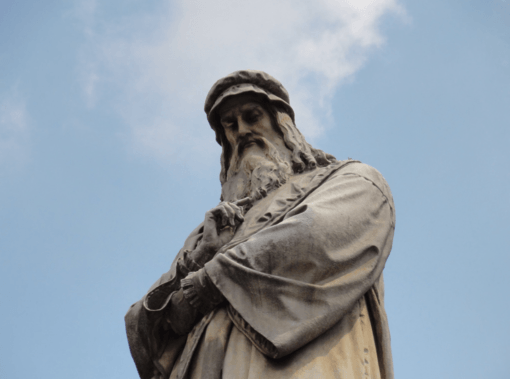
Photo by J. Simmons | CC BY 2.0
Walter Isaacson’s newly released Leonardo da Vinci doesn’t inspire.[i] The Mona Lisa challenges modern thinking. It is the culmination of a “life spent perfecting the ability to stand at the intersection of art and nature.” However, Isaacson doesn’t fully grasp that challenging intersection.
We learn of a genius motivated by creation, not results. It is what Einstein said universities should teach: the joy of receiving back, humanly, from the process of learning. Students should feel. Obsession with end results, Einstein said, undermines education. It threatens science.
Leonardo didn’t much care for results. His tangible output was meager. Paintings went unfinished, engineering projects unrealized. He failed to publish, or even share, meticulous scientific results. He spent large amounts of time designing lavish pageants that left nothing for posterity.
Yet the Mona Lisa is “a distillation of accumulated wisdom about the outward manifestations of our inner lives and about the connections between ourselves and the outer world.” It is, we learn, “Leonardo’s profound meditation on what it  means to be human.”
means to be human.”
He cared about this question. He observed people intensely, studying gestures and expressions. He dissected bodies, drawing every bone, muscle group and major organ. He knew the muscles of the lips. He wanted to know how smiles happen, and how emotions become movements.
He figured out how the aortic valve works, an achievement confirmed in recent times. Leonardo loved spiral flows. He was fascinated by “swirls of water eddies, wind currents, and hair curls cascading down a neck.” With this same love he examined the spiral flow of blood.
He held a mechanistic view of the universe two hundred years before Newton, explaining impetus and friction in the flight of birds. Yet he delighted in human spirt. His Saint John the Baptist, with its erotic allure, gave Leonardo’s “own charged meaning to ‘the Word became flesh and dwelt among us’.”
He was philosopher, scientist and artist. He saw patterns in nature, and discovered them again in the human world. A 15th century vegetarian, he paid for birds in the marketplace and set them free. He thought human beings are best understood through nature. He studied it intensely.
We are told, repeatedly throughout this book, that da Vinci’s persistent questioning – what does the tongue of a woodpecker look like, how do people walk on ice? – expressed curiosity we should all emulate. We should strive for the “childlike wonder” that makes us ask, in youth, “why is the sky blue?”
But we ask questions when we care. And we care because of who we are, how we live. Leonardo insisted on connection. No moment, no action, no thought, occurs or can be understood in isolation, he insisted. He saw no borders in nature, no lines.
“Childlike wonder” is a state of being. We train children out of it. We give them gadgets to fill their heads with information. They don’t learn to feel. Education is not about feeling. This worried Einstein.
Herein lies the bigger challenge of Leonardo’s life. Knowledge is useless if we don’t know what it explains, or might. The Mona Lisa and Lady with an Ermine show the intricate workings of minds. Connecting mind and body was Leonardo’s artistic genius. He studied the world because he felt its beauty. The connection between mind and body is what he lived.
Disappointingly, at the end of this book, we get a list. We are urged to “retain a childlike sense of wonder”, “go down a rabbit hole”, “start with details”, “get distracted”, “procrastinate”, “make lists”, and on and on for an entire chapter: Leonardo in the self-help industry.
His life provides a formula. For what? Happiness? If we learn anything from his life, it should be that the complex intersections his art expressed are not talking points for life coaches.
In 7,200 pages of notes, covering a remarkable range of intellectual passions, Leonardo reveals little about himself. Mercifully, he doesn’t tell us whether he was happy.
He was too busy looking outward, at complexity, patterns, intersections. In Les Misérables, Victor Hugo writes, “Thoughtful people rarely use the terms, the happy and the unhappy…. The true division of humanity is this. Those filled with light and those filled with darkness.”
Hugo thought truth more interesting than happiness. So, apparently, did Leonardo. Like Hugo, and myriad smart, sensitive philosophers we don’t teach – the Buddha, Chuang Tzu, Marx, Lenin, José Martí – he wanted scientific truth, not dreams.
Obscured by naive, snuggly clichés about curiosity and wonder, it is easy to miss Leonardo’s vision in this biography. It is a vision much needed in inward looking, happiness-obsessed societies. If we take his life story seriously, self-indulgence is more than moral failure; more interestingly, it is intellectually disabling.
Understood with more moral imagination than this biography expresses, the Mona Lisa teaches us that self-centredness even undermines science.
Ana Belén Montes is someone who looked outward for truth, for beauty.[ii] She’s in jail, in the US, having hurt no one. Please sign petition here.
Notes.
[i] NY: Simon and Schuster, Oct. 2017.
[ii] http://www.prolibertad.org/ana-belen-montes. For more information, write to the cnc@canadiannetworkoncuba.ca or cincoheroes@listas.cujae.edu.cu